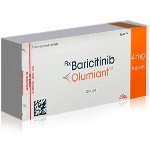Atopic Dermatitis Explained


Atopic dermatitis, often interchangeably called eczema, is one of the most common chronic inflammatory skin conditions worldwide. It affects both children and adults and is characterized by dry, itchy, inflamed skin that can significantly impact quality of life. While the condition has been extensively studied, questions remain about how best to manage it, whether it ever truly goes away, and what new treatments such as Olumiant can offer. This article explores these questions in depth, providing a comprehensive look at the disorder and its management strategies.
Understanding Atopic Dermatitis
Atopic dermatitis is a chronic skin disorder that falls under the broader category of eczema. The term “atopic” refers to a predisposition toward allergic conditions, such as hay fever and asthma, which often occur together in what is called the “atopic triad.” The skin of a person with atopic dermatitis has a weakened barrier, leading to increased water loss, dryness, and greater susceptibility to irritants, allergens, and microbes.
Clinically, the condition presents with patches of dry, red, itchy, and inflamed skin. In some individuals, the skin may thicken over time due to chronic scratching, a phenomenon known as lichenification. Flares can be triggered by allergens, stress, weather changes, detergents, and even certain foods.
What is the Difference Between Eczema and Atopic Dermatitis?
The terms “eczema” and “atopic dermatitis” are often used interchangeably, but they do not mean exactly the same thing. Eczema is a broader term that describes a group of skin conditions characterized by inflammation and irritation. This umbrella term includes atopic dermatitis, contact dermatitis, dyshidrotic eczema, seborrheic dermatitis, and several other types.
Atopic dermatitis is the most common and well-recognized form of eczema. While all types of eczema involve redness, itching, and irritation, atopic dermatitis is distinguished by its strong link with allergies and immune system dysfunction. In short, all atopic dermatitis is eczema, but not all eczema is atopic dermatitis. Understanding this distinction is important for accurate diagnosis and proper treatment.
The “3 Minute Rule” for Eczema
A widely recommended guideline in the care of atopic dermatitis is known as the “3 minute rule.” This rule emphasizes the importance of sealing moisture into the skin immediately after bathing or showering. When the skin is wet, it temporarily absorbs water, but without intervention, this hydration is quickly lost as evaporation occurs.
The “3 minute rule” advises patients to apply an emollient or moisturizer within three minutes of bathing. This simple practice helps trap moisture, restore the skin barrier, and reduce dryness and itching. Dermatologists consider it a cornerstone of eczema care, particularly for children, because consistent hydration is one of the most effective ways to minimize flare-ups and reduce reliance on stronger medications.
How to Fix Atopic Dermatitis?
While the word “fix” suggests a permanent cure, it is more accurate to think in terms of management and control. Atopic dermatitis is a chronic condition that can be controlled to the point of minimal or no symptoms, but in most cases, it is not permanently “fixed.” Effective management involves addressing both the symptoms and the underlying skin barrier dysfunction.
Treatment typically begins with lifestyle and skincare strategies. Daily moisturization, avoidance of known triggers, and the use of gentle, fragrance-free cleansers are essential. During flares, topical corticosteroids or calcineurin inhibitors may be prescribed to reduce inflammation and itching. Antihistamines can sometimes help with itch control, though they are not universally effective.
For moderate to severe cases that do not respond to topical therapies, systemic treatments may be considered. These include immunosuppressants such as cyclosporine, methotrexate, and newer biologic drugs like dupilumab. Recently, Janus kinase (JAK) inhibitors, including baricitinib (Olumiant), have emerged as promising options for patients with difficult-to-control disease.
Beyond medication, phototherapy (controlled exposure to ultraviolet light) can also be effective. It reduces inflammation and bacterial colonization on the skin, providing relief for many patients. Importantly, patient education and adherence to daily skin care routines remain the backbone of successful management.
Does Atopic Dermatitis Go Away?
A common question among patients and parents is whether atopic dermatitis ever truly disappears. The answer is complex. Many children who develop atopic dermatitis in infancy see significant improvement as they grow older, with some achieving long-term remission. Studies suggest that up to half of children with eczema may “outgrow” it by adolescence.
However, for others, the condition persists into adulthood or recurs later in life after years of remission. Even when the skin appears normal, the underlying barrier dysfunction and immune sensitivity often remain. This means flare-ups can return under stress, hormonal changes, or environmental triggers.
Therefore, while atopic dermatitis may subside or disappear for extended periods, it is better understood as a condition that can be well controlled rather than permanently cured.
The Role of Olumiant in Treatment
Olumiant (baricitinib) is an oral medication that belongs to a class of drugs called Janus kinase (JAK) inhibitors. It was initially developed and approved for rheumatoid arthritis, but its role in dermatology has grown as research revealed its effectiveness in treating atopic dermatitis.
Atopic dermatitis involves overactivation of the immune system, specifically signaling pathways that promote inflammation. JAK enzymes play a central role in transmitting these inflammatory signals. By inhibiting JAK activity, Olumiant reduces the immune overreaction that drives eczema symptoms.
Clinical trials have shown that Olumiant can significantly reduce itch intensity and skin lesions in patients with moderate to severe atopic dermatitis who did not respond adequately to topical treatments. Patients taking the drug reported improved sleep, reduced scratching, and better overall quality of life.
One of Olumiant’s key advantages is its oral administration, making it a convenient option compared to injectable biologics. However, like all systemic therapies, it carries potential risks. Side effects may include upper respiratory infections, nausea, headaches, and more rarely, serious infections or blood clots. Careful patient selection and medical supervision are necessary to ensure safety.
The approval of Olumiant for atopic dermatitis represents an important step in expanding treatment options, particularly for patients who have exhausted conventional therapies. It demonstrates the shift toward precision medicine in dermatology, where treatments are designed to target specific immune pathways rather than applying broad immunosuppression.
Living with Atopic Dermatitis
Managing atopic dermatitis extends beyond medications. Lifestyle adjustments, psychological support, and patient education all play a vital role. The chronic itch and visible skin changes can affect self-esteem, sleep, work productivity, and relationships. Support groups, counseling, and stress management techniques such as mindfulness or yoga may help patients cope with the psychological burden of the disease.
Dietary factors remain an area of ongoing research. While food allergies can worsen eczema in some children, routine elimination diets are not recommended without medical guidance. A balanced diet, rich in omega-3 fatty acids, vitamins, and antioxidants, may contribute to skin health, though evidence is not yet definitive.
Environmental adjustments can also help, including maintaining moderate indoor humidity, wearing soft cotton clothing, and avoiding harsh detergents or soaps. Parents of children with atopic dermatitis often find that structured daily routines for bathing, moisturizing, and applying medication reduce both flare frequency and severity.
Future Directions in Treatment
The landscape of atopic dermatitis management is rapidly evolving. Beyond Olumiant, other JAK inhibitors such as upadacitinib and abrocitinib are being developed and approved for similar indications. Biologic therapies targeting different inflammatory pathways are also expanding.
Researchers are investigating the role of the skin microbiome, particularly the overgrowth of Staphylococcus aureus, in driving flares. Probiotics, prebiotics, and microbiome-modulating therapies may become part of future care strategies. Gene-based research may also help identify individuals at greatest risk and lead to preventive measures before the disease develops.
Ultimately, the goal is not only to control symptoms but to address the underlying mechanisms of skin barrier dysfunction and immune dysregulation. With continued advances, long-term remission and possibly true cures may become more achievable.
Conclusion
Atopic dermatitis is more than just dry, itchy skin — it is a complex chronic disease rooted in immune system dysregulation and barrier dysfunction. While often confused with other forms of eczema, atopic dermatitis is distinct in its association with allergies and chronic relapsing course.
The “3 minute rule” remains a simple yet powerful daily habit for maintaining skin hydration. Management requires a combination of moisturization, trigger avoidance, topical treatments, and, in more severe cases, systemic therapies. While the condition may improve with age and sometimes disappear for years, it is better viewed as a lifelong condition that can be controlled rather than cured.
New treatments such as Olumiant are transforming care for patients with severe atopic dermatitis, offering hope for those who previously struggled with limited options. With ongoing research and innovations, the future of eczema treatment looks increasingly promising, moving closer to the day when patients can enjoy long-lasting relief and improved quality of life.
Drug Description Sources: U.S. National Library of Medicine, Drugs.com, WebMD, Mayo Clinic, RxList.
Reviewed and Referenced By:
Dr. Lawrence Eichenfield, MD Professor of Dermatology and Pediatrics, University of California, San Diego. Internationally recognized expert in pediatric dermatology, with extensive research and publications on atopic dermatitis management and biologic therapies.
Dr. Amy S. Paller, MD Chair of Dermatology, Northwestern University Feinberg School of Medicine. Specialist in inflammatory skin disorders and clinical trials of emerging therapies, including JAK inhibitors and biologics for atopic dermatitis.
Dr. Jonathan Silverberg, MD, PhD, MPH Associate Professor of Dermatology, George Washington University. Focuses on epidemiology and treatment of eczema, with expertise in chronic itch, comorbidities, and quality-of-life impacts of atopic dermatitis.
Dr. Emma Guttman-Yassky, MD, PhD Chair of Dermatology, Icahn School of Medicine at Mount Sinai. Leading researcher in immunology of atopic dermatitis, with groundbreaking work on cytokine pathways and targeted treatments like dupilumab and JAK inhibitors.
Dr. Peter Lio, MD Clinical Assistant Professor of Dermatology and Pediatrics, Northwestern University. Co-founder of the Chicago Integrative Eczema Center, providing expertise in both conventional and holistic approaches to eczema care.
(Updated at Aug 29 / 2025)

